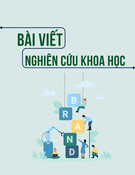
JST: Engineering and Technology for Sustainable Development
Volume 35, Issue 2, April 2025, 026-032
26
Authenticating the Origin of Pakchoi Using Metal Content
in the Edible Parts of Pakchoi at Hanoi Market, Vietnam
Mac The Vinh1,2, Truong Ngoc Minh3, Nguyen Thi Huong4, Nguyen Thi Minh Tu1,5*
1School of Chemistry and Life Sciences, Hanoi University of Science and Technology, Ha Noi, Vietnam
2Hanoi University of Industry, Ha Noi, Vietnam
3Center for High Technology Research and Development - Vietnam Academy of Science and Technology,
Ha Noi, Vietnam
4Hanoi University of Science and Technology, Ha Noi, Vietnam
5New Industry Creation Hatchery Center (NICHe), Tohoku University, Sendai, Miyagi, Japan
*Corresponding author email: tu.nguyenthiminh@hust.edu.vn
Abstract
Pakchoi (Brassica rapa subsp. chinensis) is a familiar vegetable and is widely grown in Vietnam and many
other Southeast Asian countries. Like other Brassica plants, pakchoi has long been known for its ability to
accumulate a variety of metals. Using the metal content data in the edible parts of pakchoi from Chuong My,
Me Linh, and Dan Phuong (3 areas specializing in growing pakchoi serving Hanoi market) during the period
from September 2021 to April 2024, this study evaluated the ability to authenticate the origin of pakchoi using
multivariate statistical analysis methods (Principal Component Analysis-PCA and Linear Discriminant
Analysis-LDA). 27 kinds of metal in the edible parts of pakchoi from these areas, including Li, Bo, Mg, Al, Ti,
V, Cr, Mn, Zn, Fe, Co, Ni, Cu, As, Rb, Sr, Nb, Mo, Ag, Cd, Sb, Cs, Ba, Hg, Tl, Pb, and Bi, were determined by
Inductively Coupled Plasma Mass Spectrometry (ICP-MS). The PCA and LDA methods were used and LDA
method was successful in distinguishing the three geographical areas. Of the total 27 metals, the characteristic
metals used for distinction in LDA were shown, including: As, Ba, Co, Cs, Li. In addition, the model constructed
by LDA showed the ability to accurately recognize 27/27 prepared prediction samples. This research shows
the potential of using metal content results in building a model to authenticate the geographical origin of
pakchoi in particular and other vegetable crops in general in the food market in Hanoi, Vietnam.
Keywords: Pakchoi, Hanoi, metal content, ICP-MS, LDA, PCA.
1. Introduction
*
Pakchoi (Brassica rapa subsp. chinensis) is a
vegetable originating from China that has long been
widely used in Southeast Asian countries such as
Vietnam, Laos, Indonesia, etc. Pakchoi has a yield of
10-20 tons/ha for small varieties and 20-30 tons/ha for
large varieties [1]. With the ability to withstand heat,
humidity, and pests, pakchoi has become one of the
popular vegetables on the daily dining table of many
Vietnamese people. Depending on characteristics,
habitat, and morphology, pakchoi in the world is
divided into many types: Tai Sai pakchoi, White
pakchoi, Green Fortune pakchoi [2], Dwarf Carton
White pakchoi, Joi pakchoi, Meiquin pakchoi, etc. In
Vietnam, Green Fortune pakchoi is grown and used the
most.
In addition to being rich in vitamins (A, B, C) and
flavonoids (633-982 µg/g carotenoids, of which lutein
accounts for 40-43%, violaxanthin 17-28%,
neoxanthinmade 13%, and β-carotene 19-27%),
ISSN 2734-9381
https://doi.org/10.51316/jst.181.etsd.2025.35.2.4
Received: Aug 21, 2024; revised: Dec 12, 2024;
accepted: Jan 20, 2025
pakchoi also contains minerals: calcium, manganese,
potassium, zinc, iron, sodium, magnesium, selenium,
phosphorus, etc. [3]. This makes the determination of
metal content components in pakchoi potentially a sign
to support the geographical traceability of pakchoi.
Nowadays, the problem of overuse of chemicals
and pesticides in fruits and vegetables is increasingly
appearing, along with the appearance of fruit and
vegetable products, food of unknown origin competing
directly with domestic products. To regain consumer
trust, tracing the origin of food products in general and
fruits and vegetables in particular is more necessary
than ever.
2. Materials and Methods
2.1. Sampling and Storing Samples
Pakchoi is grown and collected from the stems
and leaves (edible parts) in Chuong My, Dan Phuong,
and Me Linh areas with specific addresses listed in
Table 1 (3 locations per area, 9 locations total). These





















